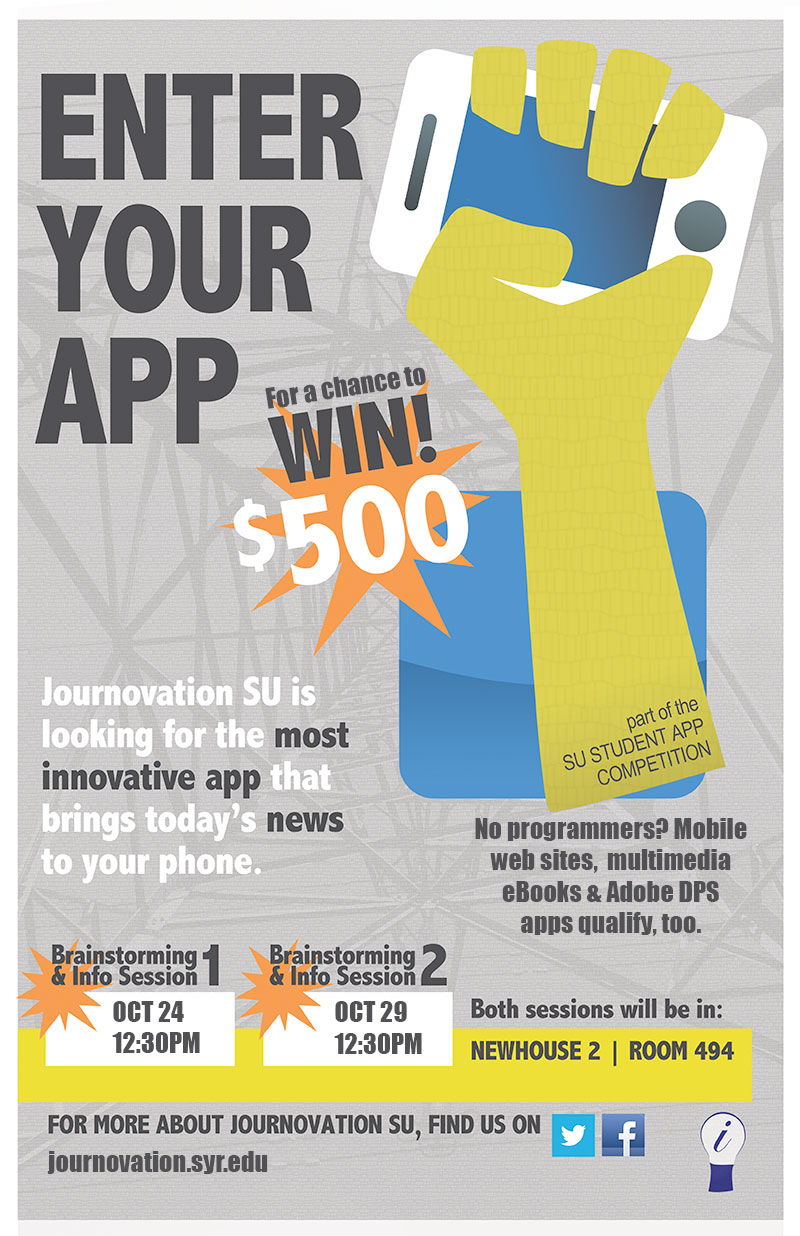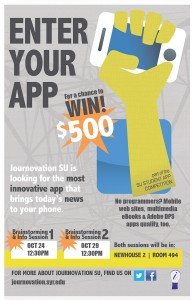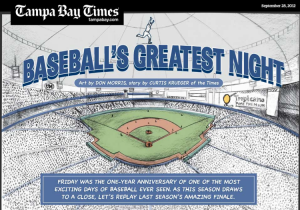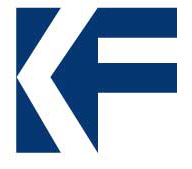Author Archive: Brian Moritz
Brainstorming sessions for News App contest
October 18, 2012
As we announced yesterday, we’re excited to be a part of the SU Student App Competition. We’re offering a $500 prize for the best student-designed news/journalism/civic media app.
 If you want more information on the contest, if you have an idea for an app but don’t know what to do next, or if you’re interested in this but don’t know where to start, we’re holding a couple of brainstorming sessions in the next two weeks:
If you want more information on the contest, if you have an idea for an app but don’t know what to do next, or if you’re interested in this but don’t know where to start, we’re holding a couple of brainstorming sessions in the next two weeks:
The first is Wednesday, Oct. 24, 12:30 p.m. The second is Monday, Oct. 29, 12:30 p.m.
Both sessions will be held in our office in Newhouse 2, Room 494. We’ll provide some food and the space to work on your idea and maybe find some collaborators.
If you have any questions, you can email Dan or Brian. Or follow us on Twitter.
Create the next great news app for a chance to win $500
October 16, 2012
 Any SU student who has a mobile app, or mobile-friendly web site, that has journalistic value should consider entering it into the SU Student App competition: http://idea.syr.
Any SU student who has a mobile app, or mobile-friendly web site, that has journalistic value should consider entering it into the SU Student App competition: http://idea.syr.- Innovation: How unique and creative is the app? Are there similar ideas out there? What makes the app better than others?
- Integrity: How robust is the app? Is the app just a functioning prototype or well-tested and ready for release?
- Impact: How useful is the app? Who will be using it? How will it change people’s lives and society?
Team Eligibility:
- At least one team member must be a full time SU student. Both graduate and undergraduate students are eligible. There is no limit on the number of team members.
- In order to receive an award, at least one team member must have the legal status to receive a monetary prize.
Requirements:
- Each competing team must develop an app: a set of software programs that runs on one of the following platforms:
- Web browsers e.g. Firefox (“web app”)
- Smart phones e.g. iPhone (“mobile app”)
- Tablet computers e.g. iPad (“tablet app”)
- Desktop operating systems e.g. Windows (“desktop app”)
- Programmable hardware platforms e.g. Arduino
- At least 50% of the code must be written by the team members (which must be either current Syracuse University students or 2012 graduates of Syracuse University), with the exception of the use of software libraries (e.g. APIs, SDKs) that are available to the public through licensing, which may be proprietary or non-proprietary.
- The majority (more than 50%) of the code must be written during the 2012-2013 academic year by the SU students on the team.
- Each team must demonstrate the functioning app at the Demo Alley section of Entrepalooza, on the day of the competition, after passing the first round of judging.
- Each team can submit only one app and each individual in the competition can belong to only one team.
- Each application must include all the required information on the application form. The entire source code is not part of the application. However, the source code of the app must be accessible to the judges and organizers upon request after the submission through the period of competition.
- Each team must be the legal owner of the entire software submitted to the competition.
- A submission may be disqualified if it fails to comply with any of the requirements above.
Comic book sports coverage: Journovation interview with Don Morris
October 15, 2012
One of the neatest things I’ve seen in the sports pages lately came last month in the Tampa Bay Times. To commemorate the one-year anniversary of the end of the 2011 baseball season – in which the Tampa Bay Rays clinched a dramatic playoff berth on the last day of the season – the Times retold the story of that day in comic book form.
I interviewed Don Morris, who drew the comic book, about the project via email:
Where did the idea for a comic book narrative come from?
I’m a big fan of comic narratives and have been looking for an opportunity to do one in our own paper. I have always done journalistic sketchbooks to report everything from the Super Bowl in Tampa to hurricane evacuation centers at the height of storms. A comic narrative to me was the perfect next step to retelling a news event in a dramatic and fun way. Problem has always been getting the time to do this.
When this idea first came up, what was your first reaction?
I brought the idea of doing a comic narrative for Game 162 with my good friend Curtis Krueger, a writer friend of mine at the Times. His beat is courts, but he is a big Rays fan. We started talking about this for a year ago about a week after the historic game. When spring training came around in March, we wanted to do it in our annual Rays season preview section. Problem was it was a look back – not a look forward, duh. So we aimed for the All Star break, but I couldn’t get the time to sketch due to some special projects, vacation and the usual news events that keep us from doing these types of enterprise projects.
What about this story lent itself to being told in this format?
1. The biggest reason is that Game 162 was called the greatest regular season game ever played by baseball experts throughout the sports world. That made this an iconic event, especially to Rays fans immediately.
2. I listened to the game by radio because I couldn’t be near a TV. As a result, I pictured the whole game the way I used to when I was a kid. It made the game all the more memorable to me. The experience of listening by radio made the game take on a legendary feel to me right away. I grew up reading sports comics in the newspaper so I knew this would be a fun game to recreate with comics. It also would help me connect visually to the game.
3. Besides the breaking news and follow-up coverage of this amazing game and all the visuals that go along with that, highlights from the game were rehashed countless times throughout the year by the Rays organization and our own local media. This was another way to retell the story in a way fans could reconnect and celebrate anew on the one year anniversary.
What was the drawing process like?
Once we had a storyboard, the drawing part was fun – even with lots of pressure. Storyboarding is crucial because it allows the script and drawings to “dance” as one. By having the storyboard, I knew exactly what I was looking for in reference and what I wanted to do on the pages. Believe me, it’s not fun to sit down at a drawing board without a plan and even worse to get done and have to go back to redraw! The drawing process for this project was highly pressurized because I had only a week and a half to do all drawings and get them on the page so text could be refined and of course go through all editing stages.
What’s the reaction to this been like, both inside and outside the newsroom?
The reaction has been enthusiastic in the community and our newsroom. The online version was published on the Friday before it appeared in our Sunday paper and shared hundreds of times on Facebook. We overprinted the section and distributed it at the last game of the season to fans at the game. I have to admit, I was surprised at how surprised my Times colleagues were to see this type of storytelling in our newspaper. We have always prided ourselves at our willingness to tell stories in unconventional ways.
Was there any thought into making this an interactive story?
In the very beginning, we fancied making this an e-book and including video clips and audio interviews. That is our goal for the next time we do this.
What did you learn from doing this?
This reconfirmed to me that even with a very short period of time to produce something like this, it’s possible when everyone buys in on an idea and clears the deck to make its completion possible. This project reinforced for me how special The Tampa Bay Times is as a place for telling stories in unconventional ways.
Are you a comic book fan? If so, what’s your favorite?
I’m not so much a comic book fan as I am a fan of illustrated stories. If it’s a good story and it’s illustrated and designed in a compelling way I love it. It doesn’t matter whether it’s in a book, magazine, newspaper or online. My favorite right now is Josh Neufeld’s “New Orleans After the Deluge” (Pantheon Books).
The future of journalism is bright because …”
September 28, 2012
It’s not hard to find people talking about what’s wrong with journalism these days.
But that’s not what we’re focused on here. One thing we believe is that this is a potential golden age of journalism. In all the changes happening to the news industry, we see opportunities. Opportunities for entrepreneurs, for young journalists and for veteran ones. Opportunities to use new tools and old knowledge to create great journalism for the 21st century.
In that vein, we are asking journalism innovators (we call them journovators) to complete this sentence: The future of journalism is bright because __________
We’ll collect their answers here in a running file. Check in when you need a moment of inspiration.
The future of journalism is bright because __________
- “We have the ability to use a lot of new tools to tell narratives.”
– Laura Norton Amico, Homicide Watch D.C. - “We still attract an amazing array of creative people, and people still want to know what’s happening in their communities and the world.
–Steve Buttry, Digital Transformation Editor for Digital First Media and Journal Register Company. - “There’s so many ways to find people to read your stories and to consume all the various products that you’re putting out. It’s a really exciting time to be working and to be publishing, and there’s just so many things that you can do that were never possible before with stories. Pretty much, as big as you can dream, that’s what you can produce. And that’s pretty cool.”
–Jake Naughton, multimedia projects coordinator for The Pulitzer Center. - “The future of journalism is bright because of journalists. Journlists are really smart and really creative thinkers, and we really have evolved with the industry. Whatever happens in journalism is because of the people who power it.”
– Mark S. Luckie, Manager of Journalism and News for Twitter. - “People have a connection to their virtual selves, and everybody is gaming, and gaming’s a great environment to make money, and if we start taking that environment to buiold news storuies, we’re gonna get rich again.”
– Nonny de la Pena, Immersive Journalist.
Knight Foundation announces News Challenge winners
September 20, 2012
The second round of winners in the Knight Foundation’s News Challenge were announced on Thursday at ONA, and each of the winners are potentially exciting innovations in the news and journalism space. This challenge revolved around data.
The winners are:
• Local Data, which is a set of tools that allow users to easily collect and organize data about their local communities.
• OpenStreet Map, a community mapping project, received a grant to build a set of tools that will allow more people to add information to maps.
• Census.IRE.org, which helps journalists more easily navigate the always challenging world of US Census data. The Knight Foundation award will allow the group to expand its work into other data sets.
• PopUpArchive, which allows users to better organize multimedia content online, making it searchable and sharable.
• Open Elections, which will create a standardized set of election results for federal and statewide elections in the United States.
• Safecast Radiation & Air Quality, which is striving to create a real-time map of the air quality throughout the United States.
We’re looking forward to learning more about all of these projects and perhaps interviewing them for the site.
For more information on all the projects, visit the Idea Lab.
About Brian Moritz
September 20, 2012
Brian Moritz
Editor, Journovation Journal
Research assistant, Peter A. Horvitz Endowed Chair for Journalism Innovation
Doctoral student, S.I. Newhouse School of Public Communications
 I’m a former sports reporter who walked away from my beat to find out why newspapers are struggling, what they can do about it and how the Internet is changing the way the media does business.
I’m a former sports reporter who walked away from my beat to find out why newspapers are struggling, what they can do about it and how the Internet is changing the way the media does business.
Along with my duties as the Journovation Journal Editor, and as a research assistant for the Peter A. Horvitz Endowed Chair for Journalism Innovation, I’m a second-year doctoral student at the S.I. Newhouse School of Public Communications at Syracuse University. My research focuses on journalists’ routines and how they are evolving. My research also focuses on media sociology and sports media and communications. I’ve presented my research at regional and national AEJMC conferences, as well as the Summit on Communication and Sport.
Before turning to school in 2009, I spent 10 years as a newspaper sports reporter. I worked for the Press & Sun-Bulletin (Binghamton, N.Y.) and The Times Herald (Olean, N.Y.). I’ve written for The Boston Globe, The Boston Herald, the Fort Worth Star-Telegram and the Baltimore Sun, among others. I’ve covered college basketball, minor-league baseball, the NCAA Tournament, the NHL playoffs, and the NFL, NBA and MLB. I voted in the AP men’s basketball Top 25 and broke coverage of the 2003 St. Bonaventure men’s basketball recruiting scandal, for which I won top-10 in the nation in the APSE national writing contest. I also won several writing awards in the New York State Associated Press Association state contest.
Journovator spotlight: Jake Naughton
September 17, 2012
Jake Naughton, the multimedia projects coordinator for The Pulitzer Center, spoke with Brian Moritz on Sept. 13 about his work creating digital journalism books.
[youtube]http://youtu.be/-ieEkbbw6Ds[/youtube]
Naughton discussed how The Pulitzer Center is creating books of original reporting that can be read on an iPad using the iBooks Author software. We talked about how these books can become multimedia projects and how they can help news organizations find new audiences.
The video runs about 20 minutes.
For more info on these books, visit The Pulitzer Center .
Journovator spotlight: Steve Buttry
September 17, 2012
Steve Buttry, an experienced digital journalist, joined Dan Pacheco’s “Creating the Next News Start-Up” class on Sept. 11 via Google+ Hangout.
[youtube]http://www.youtube.com/watch?v=EP2vxLRcuCM&feature=plcp[/youtube]
Steve, who works as Digital Transformation Editor for Digital First Media and Journal Register Company, spoke with the class about the changes going on within the newspaper industry as the print-to-online shift continues. He discussed his work online and in print and what the future holds for journalism.
The video runs about an hour and 20 minutes.
For more of Steve’s thoughts, visit his blog.
Journovation spotlight: Homicide Watch D.C.
September 17, 2012
There are at least two types of journalism innovations we’re interested in studying. There are the technical innovations that are changing the way news is gathered, the way news is delivered and the way news is consumed. And there are also conceptual innovations that are changing the way we as journalists view what is “the news.”
One site that is demonstrating both these types of innovations is Homicide Watch D.C.
Homicide Watch DC, which is run by Laura Amico and Chris Amico, covers every murder in Washington, D.C. The site covers every case, every step of the way, from murder to adjudication.
The site recently completed a successful Kickstarter campaign, raising more than $40,000 in a month. Because Laura Amico is on fellowship this academic year at Harvard (where she’s a Nieman-Berkman fellow), the site would have gone dark if they hadn’t raised enough money to pay for reporters to run the site during this year.
“Nobody wanted the site to go down,” Laura Amico said in a Google+ Hangout on Sept. 17. “No one in the community wanted it to go down. So we decided to turn it into a student reporting lab.”
The money raised will allow the Amico’s to hire at least five student interns to run the site this year. The campaign also raised the site’s profile, with David Carr writing about it in The New York Times and Clay Shirky writing an impassioned call for funding. “Homicide Watch matters because they are more than just thorough, they’re innovative,” Shirky wrote.
In several ways, Homicide Watch DC is re-conceptualizing what local journalism looks like in the digital world.
One of the most obvious is in its focus. Homicide Watch DC is intensely local and intensely focused. It works under the banner: “Mark every death. Remember every victim. Follow every case.” It’s a radically simple notion – the Amicos cover every murder in Washington D.C., every step of the way.
The approach was born out of Amico’s experience as a newspaper crime reporter and her own curiosity when she moved to Washington D.C. in 2009.
“I didn’t understand how the individual cases fit into a bigger narrative,” she said. “I didn’t know which ones fit in, and I thought I needed to get a handle on the 100s of cases. And that was a smart decision. It let us review the assumptions of which crimes are newsworthy.”
Those assumptions are built into the work routines of print and television journalists.
“I think TV media does some of the best crime coverage, especially here in DC,” Amico said. “But they’re looking for that good shot, that good scene. And if happened late at night and it’s cleaned up by morning, there’s no shot. For print, there are different requirements.”
For Homicide Watch, D.C., there are no requirements. There is no news judgement, no wondering if this is worthy a story or not. If it’s a homicide it’s covered. Same as every other one.
To do so brings in the technological innovation – a database that is the site’s engine. The database allows the Amicos to follow each case, to collect data on every murder in Washington and to publish that information as they receive it. This information, which is often gathered piecemeal as it comes in, goes into the database.
“As I’m reporting on a case, I can fill in the location, the age, whatever,” Amico said. “So when, say, it’s Monday morning, there were three murders of the weekend, is that a lot? Or if I want to go deeper – who was killed this year, or are there a lot of plea deals vs. verdicts, I can do all of that with our database.”
The technological aspect of the site highlights another innovative approach the Amico’s take to their site. The site isn’t built around stories in the way that newspapers are or traditional news organizations are. It’s built around the database. Stories are a part of that and come out of that. But the crux of the site is the information, not the story.
“I love to write, I became a journalist because I love to write, and when I look at some of the things on Homicide Watch, I think ‘This isn’t all great writing,'” Amico said. “It’s a lot more about the information and being a community resource than it is about great writing. Ideally, at some point, there ends up being a well-written story. But I don’t have to come back and write the 40-inch story the next day about it. At Homicide Watch, we can take the time we need to get there and to build narratives.”
That time also allows for one of Homicide Watch’s other conceptual innovations. It is built, in many ways, around the community it serves. Community members comment on stories, connect through email, social media and any other way you can imagine. The site shows that being a news organization is as much about being a community resource than it is about being a reporting center.
This comes through in how Amico deals with the victims’ families.
“When I worked as a traditional reporter, you’d go out to a crime scene and you were not allowed to come back without “The Quote,” she said. “The way we do things now, I don’t need that quote immediately. If their mother or brother would rather not say something to me right now, if they’re not ready to talk, I don’t want to force them to. Instead, I’ll give them my card and tell them I’m doing a story for tomorrow, if you would like to say something, you can leave a comment on the story or here’s how to get in touch with me later, here’s my e-mail, my phone number. If you’d like to get in touch with me later, that’s fine.
It really puts the power in their hands.”


